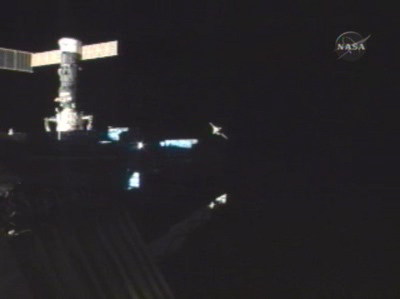NASA's Big Astronaut Trash Problem

As we explore and reach farther out into the cosmos, what will we do with all of our trash?
For astronauts aboard the International Space Station, storage space is extremely valuable and limited — but even astronauts have garbage. In addition to taking up precious space, this garbage creates potential physical and biological health and safety hazards for the astronauts. On the space station, astronauts currently squeeze their garbage into trash bags and, for temporary periods of time, store up to 2 metric tons of trash on board. They then send the trash out on commercial supply vehicles, which either reach Earth or burn up in reentry.
But what will happen to these tons of trash when astronauts are much farther from Earth? The farther we travel into the solar system, the more complicated it will be to effectively manage and dispose of trash. NASA thinks that the key to this big space-trash problem could be addressed with technology that compacts and processes trash, according to a new statement from the agency. [Gallery: Visions of Deep Space Stations for Exploration]
In an effort to ensure astronaut safety and find an improved trash solution, NASA has sent out a call to U.S. companies to create prototype compactors and trash-processing systems. The agency is looking for innovative designs that could not only compact trash but also remove hazardous components, and process and remove pieces that could then be repurposed or recycled.
Resources are limited on the space station, and they would become even more so on a deep-space mission with no resupply. So, NASA is hoping that this technology will also be able to help astronauts reuse materials more effectively.
Proposals that look to fill this void will have a variety of NASA technologies to inspire them. Previously, NASA scientists designed a heat melt compactor, which recovers water from trash using heat transfer and compacts the trash; and "trash to gas" technologies, which convert trash into methane gas that could be used as a rocket propellant. Researchers have even developed trash-compacting technology that could help astronauts turn trash into a space radiation shield.
The search for the next great trash solution will occur in two parts, according to the statement. First, NASA will select companies that will go on to create a concept for a system that compacts and processes trash. In this first phase, the companies will go through design reviews with NASA and complete ground demonstrations of their prototype. In the second phase, the companies will build a flight unit that could be tested on the space station by 2022.
Breaking space news, the latest updates on rocket launches, skywatching events and more!
NASA has been very public about its intention to not only revisit the moon, but also push farther out into the solar system and explore deep space. Effective trash-processing and -compacting technology will maximize space on future spacecraft, increase crew safety and make the most of the limited resources on board.
Email Chelsea Gohd at cgohd@space.com or follow her @chelsea_gohd. Follow us @Spacedotcom, Facebook and Google+. Original article on Space.com.

Chelsea “Foxanne” Gohd joined Space.com in 2018 and is now a Senior Writer, writing about everything from climate change to planetary science and human spaceflight in both articles and on-camera in videos. With a degree in Public Health and biological sciences, Chelsea has written and worked for institutions including the American Museum of Natural History, Scientific American, Discover Magazine Blog, Astronomy Magazine and Live Science. When not writing, editing or filming something space-y, Chelsea "Foxanne" Gohd is writing music and performing as Foxanne, even launching a song to space in 2021 with Inspiration4. You can follow her on Twitter @chelsea_gohd and @foxannemusic.

